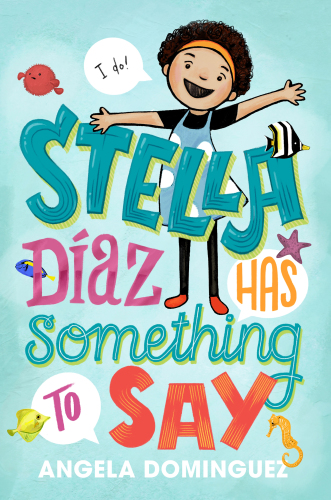
Stella Díaz Has Something to Say
Stella Diaz Series, Book 1
فرمت کتاب
ebook
تاریخ انتشار
2018
Lexile Score
650
Reading Level
2-3
ATOS
4.2
Interest Level
4-8(MG)
نویسنده
Angela Dominguezناشر
Roaring Brook Pressشابک
9781626728592
کتاب های مرتبط
- اطلاعات
- نقد و بررسی
- دیدگاه کاربران
نقد و بررسی

November 6, 2017
Picture book author-illustrator Dominguez (Sing, Don’t Cry) moves into middle grade with the story of Stella Díaz, whose family moved to Chicago from Mexico City when she was a baby. Now in third grade, Stella doesn’t always feel like she belongs, especially after she learns more about her resident status at school (“because of this green card, I’m an alien?”). Stella goes to speech therapy class to learn “how all the letters and words are supposed to sound in English,” but she finds it hard to speak up, especially when new student Stanley arrives in school. Stanley is complimentary of Stella’s artwork (one of her two passions, along with fish), but Stella feels extra shy around him. Drawing on her own childhood, Dominguez smoothly blends Spanish and English into the narration and dialogue, Stella’s Mexican-American culture fully informs her perspective and family life, and chunky spot art helps establish the setting. Readers should easily relate to Stella, her struggle to use her voice, and the way she feels caught between worlds at school and at home. Ages 6–9. Agent: Linda Pratt, Wernick & Pratt.

December 1, 2017
Speaking up is hard when you're shy, and it can be even harder if you've got two languages in your head.Third-grader Estrella "Stella" Diaz, is a shy, Mexican-American girl who draws pictures and loves fish, and she lives in Chicago with her mother and older brother, Nick. Jenny, Stella's best friend, isn't in her class this year, and Stella feels lonely--especially when she sees that Vietnamese-American Jenny is making new friends. When a new student, Stanley Mason, arrives in her class, Stella introduces herself in Spanish to the white former Texan without realizing it and becomes embarrassed. Surely Stanley won't want to befriend her after that--but he seems to anyway. Stella often confuses the pronunciation between English and Spanish sounds and takes speech classes. As an immigrant with a green card--a "legal alien," according to her teacher--Stella feels that she doesn't fully belong to either American culture or Mexican culture, and this is nicely reflected in her not being fully comfortable in either language, an experience familiar to many immigrant and first-generation children. This early-middle-grade book features italicized Spanish words and phrases with direct translations right after. There is a small subplot about bullying from Stella's classmate, and readers will cheer as they see how, with the help of her friends and family, Stella overcomes her shyness and gives a presentation on Jacques Cousteau. Dominguez's friendly black-and-white drawings grace most pages.A nice and timely depiction of an immigrant child experience. (Fiction. 7-10)
COPYRIGHT(2017) Kirkus Reviews, ALL RIGHTS RESERVED.

January 1, 2018
Gr 3-5-When Stella was a baby, her family moved from Mexico City to Arlington Heights, near Chicago, where Stella still lives with her divorced mother and supportive older brother. Stella struggles to pronounce English words and regularly attends speech therapy at school. She's not confident in her Spanish skills either; she never has the right words when her Mexican relatives visit. When Stella learns that she's an "alien" because she only has a green card, she wonders, "If I become a citizen, will I finally feel normal?" With the help of her family and friends, Stella learns to shine like the star she's named after as she deals with the class bully, survives her first spelling bee, and proudly aces her oral presentation. Realistic relationships ground this character-driven story; most notably, Stella's relationships with her loving mother and not-so-great, mostly absent father. School and home life feature prominently. Cultural markers, including food and music, are incorporated into the story just as naturally as the Spanish words explained in context. Dominguez's black-and-white spot illustrations are friendly and appealingly childlike, providing context and visual variety. According to the author's note, this story is "82.9 percent based" on Dominguez's childhood. Like Stella, Dominguez struggled with both languages, was born in Mexico, and had a Vietnamese best friend. VERDICT Fans of Clementine and Alvin Ho will be delighted to meet Stella. A first purchase.-Amy Seto Forrester, Denver Public Library
Copyright 2018 School Library Journal, LLC Used with permission.

spacepenguin - I really like this book because I speak Spanish too. This book is mostly in English, it just has a few Spanish words in it. It is also good for kids who also want to learn a few Spanish words.

November 15, 2017
Grades 2-5 Stella is shy and has trouble speaking up when she wants to say something, largely because she jumbles languages and can't find the right words. When her teacher assigns a project and an accompanying presentation, she starts to dread having to speak in front of her class, even if it'll be about a subject she loves (marine life!). To make matters worse, she wants to befriend a new boy in her class, but she can't work up the nerve to have a conversation with him. Things come together for her with help from her goofy older brother, encouraging mother, and her best friend. Stella shows everyone that she's stronger than she looks, just like a starfish. Simple black-and-white cartoons sprinkled throughout the text break up the story just right, as Stella works up the courage to finally speak up. Based significantly on her childhood, Dominguez's novel introduces a character many readers can relate to, especially bilingual kids or English-language learners who struggle with expressing themselves. An excellent, empowering addition to middle-grade collections.(Reprinted with permission of Booklist, copyright 2017, American Library Association.)

























دیدگاه کاربران